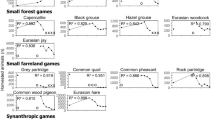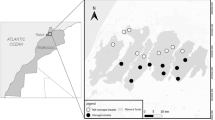Abstract
Agricultural change has transformed large areas of traditional farming landscapes, leading to important changes in the species community assemblages in most European countries. We suspect that the drastic changes in land-use that have occurred in Andalusia (southern Spain) over recent decades, may have affected the distribution and abundance of game species in this region. This article compares the distribution of the main game species in Andalusia during the 1960s and 1990s, using data from maps available from the Mainland Spanish Fish, Game and National Parks Service and from recent datasets on hunting yield distributions, respectively. Big-game and small-game species were significantly segregated in southern Spain during the 1990s, as two clearly independent chorotypes (groups of species whose abundances are similarly distributed) were obtained from the classification analysis. In contrast, big-game and small-game species were not significantly segregated several decades ago, when there was only one chorotype consisting of small-game species and wild boar. The other three ungulates did not constitute a significant chorotype, as they showed positive correlations with some species in the group mentioned above. These changes seem to be a consequence of the transformations that have occurred in the Iberian Mediterranean landscape over the last few decades. The abandoning of traditional activities, and the consequent formation of dense scrubland and woodland, has led to an expansion of big-game species, and a decrease of small-game species in mountain areas. Moreover, agricultural intensification has apparently depleted small-game species populations in some agricultural areas. On the other hand, the increasingly intensive hunting management could be artificially boosting this segregation between small-game and big-game species. Our results suggest that the conservation and regeneration of traditional agricultural landscapes (like those predominating in the 1960s) should be a priority for the conservation of small-game species.






Similar content being viewed by others
References
Acevedo P, Delibes-Mateos M, Escudero MA, Vicente J, Marco J, Gortázar C (2005) Environmental constraints in the roe deer (Capreolus capreolus Linnaeus, 1758) colonization sequence across the Iberian Mountains (Spain). Journal of Biogeography 32:1671–1680
Acevedo P, Escudero MA, Muñoz R, Gortázar C (2006) Factors affecting wild boar abundance across an environmental gradient in Spain. Acta Theriologica 51:327–336
Andrés C, de Cosano I, Pereda N (2002) Manual para la Diversificación del Paisaje Agrario. CAAE-Junta de Andalucía, Sevilla
Buenestado FJ, Ferreras P, Delibes-Mateos M, Tortosa FS, Blanco-Aguiar JA, Villafuerte R (2008) Habitat selection and home range size of red-legged partridges in Spain. Agriculture, Ecosystems and Environment 126:158–162
Carranza J (1999) Aplicaciones de la etología al manejo de las poblaciones de ciervo en el suroeste de la Península Ibérica: producción y conservación. Etología 7:5–18
Consejería de Medio Ambiente (1999) Mapa de usos y coberturas vegetales del suelo de Andalucía. Junta de Andalucía, Sevilla
Cremene C, Groza G, Rakosy L, Schileyko AA, Baur A, Erhardt A, Baur B (2005) Alterations of steppe-like grasslands in Eastern Europe: a threat to regional biodiversity hotspots. Conservation Biology 19:1606–1618
Delibes-Mateos M, Delibes M, Ferreras P, Villafuerte R (2008a) The key role of European rabbits in the conservation of the western Mediterranean basin hotspot. Conservation Biology 22:1106–1117
Delibes-Mateos M, Ramirez E, Ferreras P, Villafuerte R (2008b) Translocations as a risk for the conservation of European rabbit lineages. ORYX 42:259–264
Delibes-Mateos M, Ferreras P, Villafuerte R (2008c) Rabbit populations and game management: the situation after 15 years of rabbit haemorrhagic disease in central-southern Spain. Biodiversity and Conservation 17:559–574
Eastman JR (2004) Idrisi Kilimanjaro GIS, User Guide and Software. Clark Labs, Clark University, USA
Edwards PJ, Berny MRF (2000) Review of the factors affecting the decline of the European brown hare, Lepus europaeus (Pallas, 1778) and the use of wildlife incident data to evaluate the significance of paraquat. Agriculture, Ecosystems and Environment 79:103–905
Farfán MA, Guerrero JC, Real R, Barbosa AM, Vargas JM (2004) Caracterización del aprovechamiento cinegético de los mamíferos en Andalucía. Galemys 16:41–59
Farfán MA, Vargas JM, Guerrero JC, Barbosa AM, Duarte J, Real R (2008) Distribution modelling of wild rabbit hunting yields in its original area (S Iberian Peninsula). Italian Journal of Zoology 75:161–172
Fernández N, Delibes M, Palomares F (2006) Landscape evaluation in conservation: Molecular sampling and habitat modeling for the Iberian lynx. Ecological Applications 16:1037–1049
Fernández-Alés R, Martín A, Ortega F, Ales EE (1992) Recent changes in landscape structure and function in a Mediterranean region of SW of Spain (1950–1984). Landscape Ecology 7:3–18
Gortázar C, Herrero J, Villafuerte R, Marco J (2000) Historical examination of the status of large mammals in Aragon, Spain. Mammalia 64:411–422
Gortázar C, Millán J, Acevedo P, Escudero MA, Marco J, Fernández de Luco D (2007) A large-scale survey of brown hare Lepus euroapeus and Iberian hare L. granatensis populations at the limit of their ranges. Wildlife Biology 13:244–250
Guirado J, Ortega F (2002) La caza como actividad de desarrollo sostenible. Medio Ambiente 41:22–26
Hosmer DW, Lemeshow S (1989) Applied logistic regression. John Wiley and Sons, Inc, New York
Junta de Andalucía (1995) Medio Ambiente en Andalucía. Informe 1994. Junta de Andalucía, Sevilla
Junta de Andalucía (1996) Medio Ambiente en Andalucía. Informe 1995. Junta de Andalucía, Sevilla
Junta de Andalucía (2003) Medio Ambiente en Andalucía. Informe 2002. Junta de Andalucía, Sevilla
Kubicka E, Kubicki G, McMorris FR (1995) An algorithm to find agreement subtrees. Journal of Classification 12:91–99
Laiolo P, Dondero F, Ciliento E, Rolanco A (2004) Consequences of pastoral abandonment for the structure and diversity of the alpine avifauna. Journal of Applied Ecology 41:294–304
Lawless JF, Singhal K (1978) Efficient screening of nonnormal regression models. Biometrics 34:318–327
Lawless JF, Singhal K (1987) ISMOD: An all-subsets regression program for generalized linear models. I. Statistical and computational background. Computer Methods and Programs in Biomedicine 24:117–124
López-Ontiveros A (1991) Algunos aspectos de la evolución de la caza en España. Agricultura y Sociedad 58:13–51
Lucio A (1991) Ordenación y gestión en caza menor. In: Fuentes A, Sánchez I, Pajuelo L (eds) Manual de ordenación y gestión cinegética. IFEBA, Badajoz, pp 219–255
Márquez AL, Real R, Vargas JM, Salvo E (1997) On identifying common distribution patterns and their causal factors: a probabilistic method applied to pteridophytes in the Iberian Peninsula. Journal of Biogeography 24:613–631
Martínez J, Viñuela J, Villafuerte R (2002) Reconciling gamebird hunting and biodiversity (REGHAB). Socio-economic aspects of gamebird hunting, hunting bags, and assessment of the status of gamebird populations in REGHAB countries. Part 1: Socio-economic and cultural aspects of gamebird hunting. REGHAB, London
Matson PA, Parton WJ, Power AG, Swift MJ (1997) Agricultural intensification and ecosystem properties. Science 277:504–509
Ministerio de Agricultura (1968) Mapa Cinegético Nacional. Ministerio de Agricultura, Madrid
Moreno S, Villafuerte R (1995) Traditional management of scrubland for the conservation of rabbits Oryctolagus cuniculus and their predators in Doñana National Park, Spain. Biological Conservation 73:81–85
Myers N, Mittermeier RA, Mittermeier CG, da Fonseca GAB, Kent J (2000) Biodiversity hotspots for conservation priorities. Nature 403:853–858
Olivero J, Real R, Vargas JM (1998) Distribution of breeding, wintering, and resident waterbirds in Europe: biotic regions and the macroclimate. Ornis Fennica 75:153–175
Pineda FD, Nicolás JP, Pou A, Galiano EF (1981) Ecological succession in oligotrpohic pastures of central Spain. Vegetatio 44:165–176
Romero-Calcerrada R, Perry GLW (2004) The role of land abandonment in landscape dynamics in the SPA “Encinares del río Alberche y Cofio”, central Spain, 1984–1999. Landscape and Urban Planning 66:217–232
Sáez-Royuela C, Tellería JL (1986) The increased population of wild boar (Sus scrofa) in Europe. Mammal Review 16:97–101
Schmitt T, Rákosy L (2007) Changes of traditional agrarian landscapes and their conservation implications: a case study of butterflies in Romania. Diversity and Distribution 13:855–862
Sirami C, Brotons L, Martin JL (2007) Vegetation and songbird response to land abandonment: from landscape to census plot. Diversity and Distribution 13:42–52
Sirami C, Brotons L, Burfield I, Fonderflick J, Martin JL (2008) Is land abandonment having an impact on biodiversity? A meta-analytical approach to bird distribution changes in the north-western Mediterranean. Biological Conservation 141:450–459
Smith RK, Jennings NV, Robinson A, Harris S (2004) Conservation of European hares Lepus europaeus in Britain: is increasing habitat heterogeneity in farmland the answer? Journal of Applied Ecology 41:1092–1102
Vargas JM (2002) Alerta cinegética. Reflexiones sobre el futuro de la caza en España. Otero, Madrid
Vargas JM, Real R, Palomo LJ (1997) On identifying significant co-occurrence of species in space and time. Miscel lània Zoològica 20:49–58
Vargas JM, Guerrero JC, Farfán MA, Barbosa AM, Real R (2006) Land use and environmental factors affecting red-legged partridge (Alectoris rufa) hunting yields in Southern Spain. European Journal of Wildlife Research 52:188–195
Vargas JM, Farfán MA, Guerrero JC, Barbosa AM, Real R (2007) Geographical and environmental correlates of big and small game in Andalusia (southern Spain). Wildlife Research 34:498–506
Villafuerte R, Viñuela J, Blanco JC (1998) Extensive predator persecution caused by population crash in a game species: the case of red kites and rabbits in Spain. Biological Conservation 84:181–188
WallisDeVries MF, Poschlod P, Willems JH (2002) Challenges for the conservation of calcareous grasslands in northwestern Europe: integrating the requirements of flora and fauna. Biological Conservation 104:265–273
Zambrana JF, Titos M, Fernández M, Garrués J, Heredia V, Hernández S, Lizárraga C, Martín M, Parejo A, Pellejero C (2002) Estadísticas del siglo XX en Andalucía. Instituto de Estadística de Andalucía, Sevilla
Acknowledgments
M. Delibes-Mateos was supported by a postdoctoral grant funded by the regional government of Castilla la Mancha (JCCM) and the European Social Fund. Special thanks go to E. Martínez for providing us the maps of the abundance of game species during the 1960s, and to the Consejería de Medio Ambiente de la Junta de Andalucía for supplying the Annual Hunting Reports. We also thank Virginia H. Dale, Dave Parish, and two anonymous reviewers for helpful comments on previous drafts of the Manuscript.
Author information
Authors and Affiliations
Corresponding author
Rights and permissions
About this article
Cite this article
Delibes-Mateos, M., Farfán, M.Á., Olivero, J. et al. Long-Term Changes in Game Species Over a Long Period of Transformation in the Iberian Mediterranean Landscape. Environmental Management 43, 1256–1268 (2009). https://doi.org/10.1007/s00267-009-9297-5
Received:
Revised:
Accepted:
Published:
Issue Date:
DOI: https://doi.org/10.1007/s00267-009-9297-5




